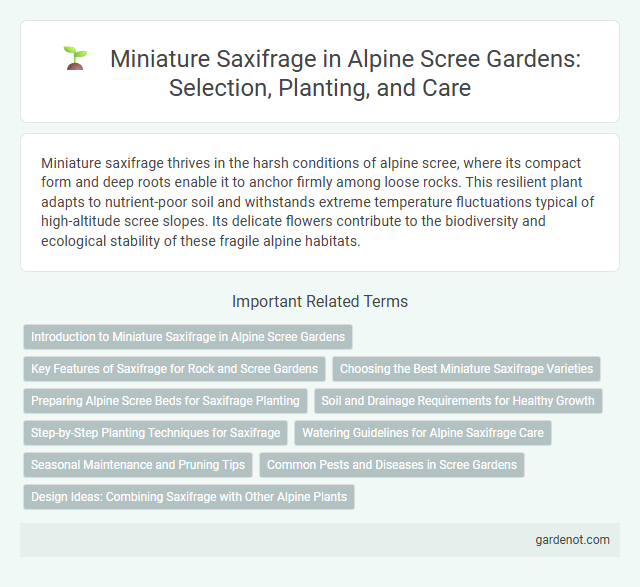Miniature saxifrage thrives in the harsh conditions of alpine scree, where its compact form and deep roots enable it to anchor firmly among loose rocks. This resilient plant adapts to nutrient-poor soil and withstands extreme temperature fluctuations typical of high-altitude scree slopes. Its delicate flowers contribute to the biodiversity and ecological stability of these fragile alpine habitats.
Introduction to Miniature Saxifrage in Alpine Scree Gardens
Miniature saxifrage (Saxifraga species) thrives in alpine scree gardens by adapting to rocky, well-drained soils and harsh mountain climates. This hardy perennial features compact rosettes of small, textured leaves and delicate star-shaped flowers that add vibrant color to scree slopes. Its natural resilience and low growth make it ideal for stabilizing loose scree while enhancing biodiversity in alpine garden settings.
Key Features of Saxifrage for Rock and Scree Gardens
Miniature saxifrage, known scientifically as Saxifraga arendsii, thrives in alpine scree environments due to its compact growth habit and tolerance for rocky, well-drained soils. Key features include its rosette-forming leaves, delicate star-shaped flowers in shades of white, pink, or red, and exceptional hardiness in cold, high-altitude conditions. Its ability to stabilize loose scree with fibrous roots makes it a valuable plant for rock and scree gardens, enhancing both erosion control and aesthetic appeal.
Choosing the Best Miniature Saxifrage Varieties
Selecting the best miniature saxifrage varieties for alpine scree involves prioritizing species with compact growth habits and exceptional drought tolerance, such as Saxifraga arendsii and Saxifraga x urbium. These varieties thrive in well-drained, rocky soils and exhibit vibrant foliage and delicate flowers, ideal for scree gardens. Their adaptability to harsh alpine conditions ensures year-round resilience and minimal maintenance.
Preparing Alpine Scree Beds for Saxifrage Planting
Preparing alpine scree beds for Miniature saxifrage involves selecting a well-drained, gritty substrate composed of sharp sand, fine gravel, and crushed granite to mimic natural alpine conditions. Ensuring efficient drainage is crucial to prevent root rot and promote healthy growth, so incorporating layers that allow water to percolate rapidly is essential. Positioning the scree bed in a sunny location with protection from excessive moisture and frost enables Miniature saxifrage to thrive in its optimal alpine scree environment.
Soil and Drainage Requirements for Healthy Growth
Miniature saxifrage thrives in well-drained, acidic to neutral soils commonly found in alpine scree environments. Optimal growth requires gritty, sandy substrates that prevent waterlogging and promote root aeration. Consistent moisture without saturation supports healthy development in this specialist alpine plant.
Step-by-Step Planting Techniques for Saxifrage
Miniature saxifrage thrives in well-drained, rocky alpine scree environments with full sun exposure. Begin by preparing a gritty, alkaline soil mix composed of sand, loam, and gravel to replicate its natural habitat. Plant small divisions or seeds in shallow crevices, ensuring consistent moisture without waterlogging, and maintain temperatures between 50-65degF (10-18degC) for optimal growth.
Watering Guidelines for Alpine Saxifrage Care
Miniature saxifrage thrives in well-drained, moist soil conditions typical of alpine scree environments, requiring careful watering to avoid root rot. Water the plant sparingly, allowing the soil to dry out slightly between watering sessions while ensuring consistent moisture during active growth periods. Overwatering should be avoided to replicate its natural habitat, promoting healthy root systems and vibrant foliage.
Seasonal Maintenance and Pruning Tips
Miniature saxifrage thrives in alpine scree environments and benefits from seasonal maintenance that includes removing dead foliage in early spring to encourage healthy growth. Pruning should be minimal, focusing on trimming away damaged or diseased stems after flowering to maintain compactness and promote airflow. Regular monitoring for pests and timely clearance of debris help prevent fungal infections, ensuring the plant's resilient performance in harsh, rocky conditions.
Common Pests and Diseases in Scree Gardens
Miniature saxifrage (Saxifraga spp.) in alpine scree gardens is susceptible to common pests such as aphids and spider mites, which can cause leaf distortion and discoloration. Fungal diseases like powdery mildew and root rot often develop in poorly drained scree, compromising plant health and growth. Regular monitoring and maintaining optimal air circulation can minimize these pests and diseases' impact on miniature saxifrage in scree environments.
Design Ideas: Combining Saxifrage with Other Alpine Plants
Miniature saxifrage thrives in rocky alpine scree environments and pairs well with plants such as alpine saxifrage, creeping phlox, and sedum to create visually striking rock garden designs. Incorporate contrasting textures by combining the delicate rosettes of saxifrage with the dense mats of creeping phlox and the succulent foliage of sedum for dynamic alpine plant arrangements. Optimizing microhabitats with well-drained, gritty soil enhances growth and ensures sustainable composition in miniature alpine scree gardens.
Miniature saxifrage Infographic

 gardenot.com
gardenot.com